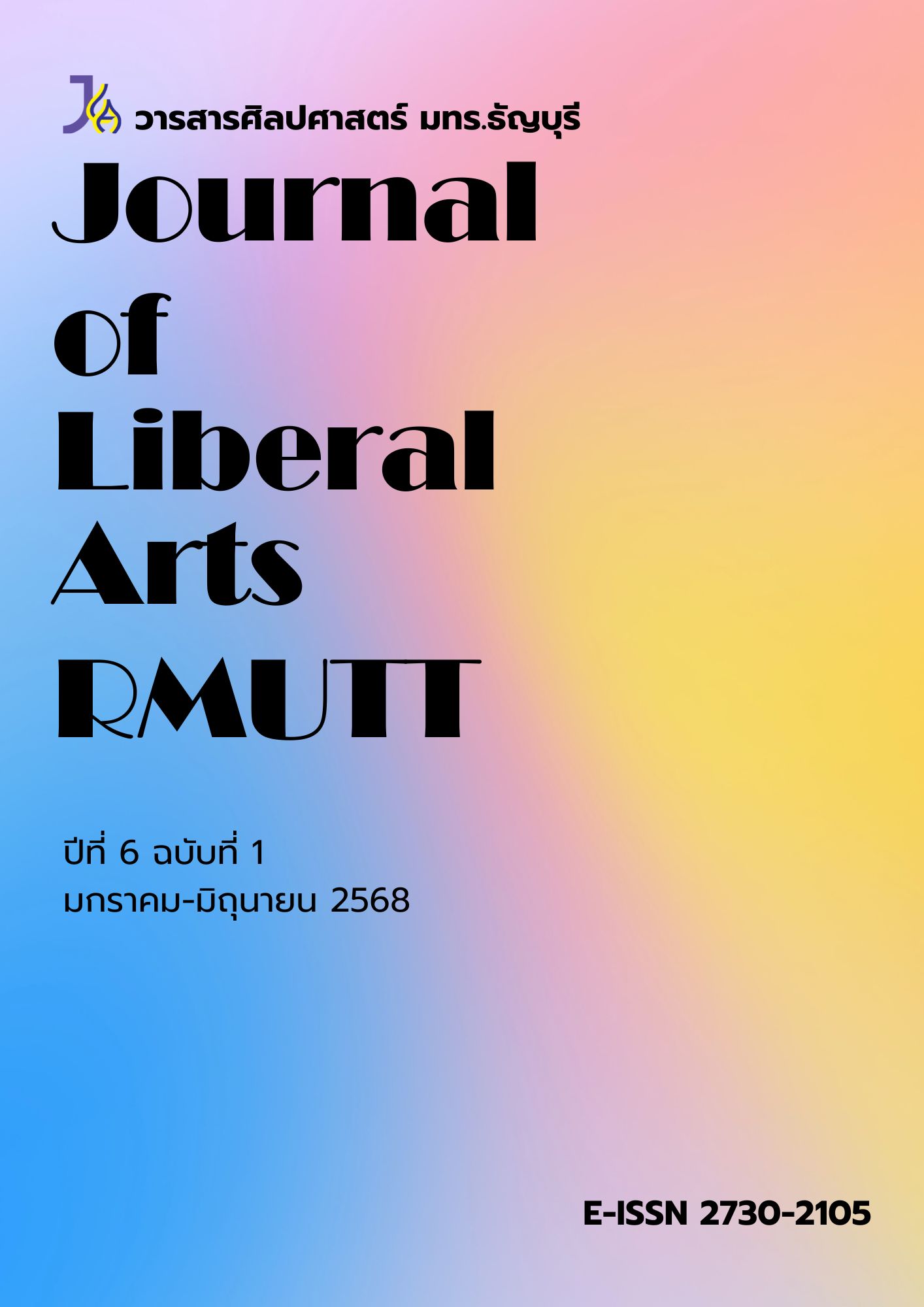Antecedent Factors Affecting Organization Loyalty of Bank for Agriculture and Agricultural Cooperatives Employees
DOI:
https://doi.org/10.60101/jla.2025.6.1.7125Keywords:
organizational loyalty, organizational commitment, bank for agriculture and agricultural cooperativesAbstract
This study aims to examine the antecedents that affect employee organizational loyalty at the Bank for Agriculture and Agricultural Cooperatives (BAAC). The sample used in this research consists of 400 employees of BAAC, selected through stratified random sampling based on the proportion of employees at the head office and regional branches. Data were collected using a questionnaire and analyzed using frequency, percentage, mean, standard deviation, and hypothesis testing through partial least squares structural equation modeling (PLS-SEM). The research findings revealed that the majority of respondents were female, aged between 31-40 years, had a bachelor's degree, were married, and earned an average monthly income of 20,001 – 30,000 baht. Overall, they rated the antecedents and organizational loyalty at the highest level. The hypothesis testing showed that career advancement opportunities, leadership, and organizational commitment significantly affected employees' organizational loyalty at BAAC, with a statistical significance level of .05. The model demonstrated a prediction power of 92.7%. The research findings can be utilized to establish human resource management guidelines for enhancing employee loyalty. The bank should develop comprehensive welfare and benefits that meet employee needs, establish clear career paths, organize continuous skill development training programs, and promote leadership styles that encourage employee participation. These measures will help reduce turnover rates and increase the organization's operational efficiency in the long term.
References
จิตรลดา ตรีสาคร, นิกร ลีชาคำ และอนุรักษ์ บุตรดาษ. (2564). ความสัมพันธ์ระหว่างแรงจูงใจของพนักงานกับความภักดีต่อองค์การในอุตสาหกรรมไฟฟ้าและอิเล็กทรอนิกส์ กรณีศึกษาบริษัท โซนี่ ดีไวซ์ เทคโนโลยี (ประเทศไทย) จำกัด. วารสารเครือข่ายส่งเสริมการวิจัยทางมนุษยศาสตร์และสังคมศาสตร์, 4(1), 46–55.
ชูชิต ชายทวีป และธนิษฐา สมัย. (2563). การวิเคราะห์รูปแบบภาวะผู้นำที่มีอิทธิพลต่อการรักษาพนักงานให้คงอยู่ในองค์การ. Journal of Administrative and Management Innovation, 8(3), 94-105.
ธนาคารเพื่อการเกษตรและสหกรณ์การเกษตร. (2566). รายงานผลการบริหารและพัฒนาทรัพยากรบุคคล ประจำปีบัญชี 2566. https://www.baac.or.th/th/cg/O19%20-%20รายงานผลการบริหารและพัฒนาทรัพยากรบุคคลประจำปี%20แก้ไข.pdf
ธนาคารเพื่อการเกษตรและสหกรณ์การเกษตร. (2567). ประวัติการก่อตั้ง. https://www.baac.or.th/th/content-about.php?content_group_sub=0001
ธัญธรณ์ อมรกิจภิญโญ, สันติ โสภาประดิษฐ์, พิมพ์ประภา อมรกิจภิญโญ, สถาพร อยู่สมบูรณ์, ชวกิจ ทองนุ้ยพราหมณ์, สมสมร วงศ์รจิต, และนเรศ สถิตยพงษ์. (2565). ปัจจัยที่มีผลต่อความภักดีต่อองค์การของครูในสถานศึกษาเอกชนของประเทศไทย. Journal of Modern Learning Development, 7(11), 435-446.
ธีทัต ตรีศิริโชติ และอุมาพร ฉ่ำช่วง. (2564). ปัจจัยแรงจูงใจที่มีผลต่อการปฏิบัติงานของข้าราชการสังกัดสำนักงานสรรพสามิตภาคที่ 2. วารสารวิชาการสังคมศาสตร์เครือข่ายวิจัยประชาชื่น, 3(1), 15-23.
บงกช ตั้งจิระศิลป์. (2564). ความสัมพันธ์ระหว่างความผูกพันต่อองค์การ ความจงรักภักดีต่อองค์การและผลการปฏิบัติงานของนักบัญชีในจังหวัดระยอง. วารสารบริหารธุรกิจอุตสาหกรรม, 3(2), 55-70.
ปรีณาพรรณ ทัพมาลี. (2563). ปัจจัยที่ส่งผลต่อความจงรักภักดีต่อองค์การของครูและบุคลากรทางการศึกษาโรงเรียนในเครือสารสาสน์ [วิทยานิพนธ์ปริญญามหามหาบัณฑิต ไม่ได้ตีพิมพ์]. มหาวิทยาลัยธุรกิจบัณฑิตย์.
ไพฑูรย์ โพธิสว่าง. (2554). หลักและวิธีการวิจัยทางสังคมศาสตร์. มหาวิทยาลัยบูรพา.
วิชชุลดา มังสั้น และกฤษดา มูฮัมหมัด. (2563). ปัจจัยที่ส่งผลต่อความจงรักภักดีต่อองค์กรของพนักงานการไฟฟ้าฝ่ายผลิตแห่งประเทศไทย (สำนักงานใหญ่). วารสารมนุษยศาสตร์และสังคมศาสตร์ มหาวิทยาลัยราชพฤกษ์, 6(2), 151-164.
เศรษฐ์ฐ พัฒนมาศ และธีทัต ตรีศิริโชติ. (2562). ปัจจัยที่ส่งผลต่อการคงอยู่ของพนักงาน สปป.ลาว ที่ทำงานในบริษัทข้ามชาติในประเทศ สปป.ลาว. วิทยาลัยพาณิชยศาสตร์บูรพาปริทัศน์, 14(1), 74-89.
Akkermans, J., Spurk, D. & Fouad, N. (2021). Careers and career development. In Oxford Research Encyclopedia of Psychology. (pp.1-40). Oxford University Press.
Al-Jabari, B. & Ghazzawi, I. (2019). Organizational commitment: A review of the conceptual and empirical literature and a research agenda. International Leadership Journal, 11(1), 78-119.
Al-Madi, F. N., Assal, H., Shrafat, F. & Zeglat, D. (2017). The impact of employee motivation on organizational commitment. European Journal of Business and Management, 9(15), 134-145.
Anitha, J. (2016). Role of Organisational Culture and Employee Commitment in Employee Retention. ASBM Journal of Management, 9, 17-28. https://www.asbm.ac.in/asbmjournal/
Antoncic, J. A. & Antoncic, B. (2011). Employee loyalty and its impact on firm growth. International Journal of Management & Information Systems (IJMIS), 15(1). https://doi.org/10.19030/ ijmis.v15i1.1598
Balthazar, P., Murphy, A. & Tan, N. (2021). Mentorship, sponsorship, and coaching for trainee career advancement. Radiographics, 41(4), E100-E102. https://doi.org/10.1148/rg.2021210085
Bass, B. M. & Avolio, B. J. (1994). Improving organizational effectiveness through transformational leadership. Sage Publications.
Bass, B. M. & Riggio, R. E. (2006). Transformational leadership (2nd Ed.). Psychology Press.
Blau, P. M. (1964). Justice in social exchange. Sociological Inquiry, 34, 193-206.
Bowlby, J. (1969). Attachment and loss, Vol. 1: Attachment. Basic Books.
Choi, D., Oh, I. S. & Colbert, A. E. (2015). Understanding organizational commitment: A meta-analytic examination of the roles of the five-factor model of personality and culture. Journal of Applied Psychology, 100(5), 1542-1567. https://doi.org/10.1037/apl0000014
Dhir, S., Dutta, T. & Ghosh, P. (2020). Linking employee loyalty with job satisfaction using PLS–SEM modelling. Personnel Review, 49(8), 1695-1711. https://doi.org/10.1108/PR-03-2019-0107
Fitrio, T., Apriansyah, R., Utami, S. & Yaspita, H. (2019). The effect of job satisfaction to organizational citizenship behavior (OCB) mediated by organizational commitment. International Journal of Scientific Research and Management, 7(9), 1300-1310. https://doi.org/10.18535/ijsrm/v7i9.em01
Greenleaf, R. K. (1977). Servant leadership: A journey into the nature of legitimate power and greatness. Paulist Press.
Hair Jr., J. F., Matthews, L. M., Matthews, R. L. & Sarstedt, M. (2017). PLS-SEM or CB-SEM: Updated guidelines on which method to use. International Journal of Multivariate Data Analysis, 1(2), 107-123. https://doi.org/10.1504/IJMDA.2017.087624
Harsono, M. & Abdullah'Azzam, M. (2023). Millennial generation organizational commitment and employee loyalty study in Indonesia: A review. The Eastasouth Management and Business, 2(01), 11-24.
Hausknecht, J. P., Rodda, J. & Howard, M. J. (2009). Targeted employee retention: Performance-based and job-related differences in reported reasons for staying. Human Resource Management, 48(2), 269-288. https://doi.org/10.1002/hrm.20279
Herzberg, F. (2015). Motivation-hygiene theory. Organizational Behavior 1, 61-74.
Hur, H. & Perry, J. L. (2020). Job security rule changes and employee organizational commitment. Review of Public Personnel Administration, 40(4), 641-668. https://doi.org/10.1177/0734371X19842622
Ibrahim, L. & Bahyaye, H. A. (2019). Participative management and employee perspective: Its impact on decision making and productivity in Nigeria. Global Journal of Management and Business Research: A Administration and Management, 19(7), 0975-585.
Imran, R., Majeed, M. & Ayub, A. (2015). Impact of organizational justice, job security and job satisfaction on organizational productivity. Journal of Economics, Business and Management, 3(9), 840-845. https://doi.org/10.7763/JOEBM.2015.V3.295
Karrasch, A. I. (2017). Antecedents and Consequences of Organizational Commitment. In Organizational Commitment in the Military. (pp. 225-236). Psychology Press.
Kot-Radojewska, M. & Timenko, I. V. (2018). Employee loyalty to the organization in the context of the form of employment. Oeconomia Copernicana, 9(3), 511-527. https://doi.org/10.24136/ oc.2018.026
Kuvaas, B., Buch, R., Weibel, A., Dysvik, A. & Nerstad, C. G. (2017). Do intrinsic and extrinsic motivation relate differently to employee outcomes?. Journal of Economic Psychology, 61, 244-258. https://doi.org/10.1016/j.joep.2017.05.004
Locke, E. A. & Latham, G. P. (1990). A theory of goal setting & task performance. Prentice-Hall.
Long, C. S., Ajagbe, M. A., Nor, K. M. & Suleiman, E. S. (2012). The approaches to increase employees' loyalty: A review on employees' turnover models. Australian Journal of Basic and Applied Sciences, 6(10), 282-291.
Maclean, R. (2019). Teachers' career and promotion patterns: A sociological analysis. Routledge.
Mehta, S., Singh, T., Bhakar, S. S. & Sinha, B. (2010). Employee loyalty towards organization-a study of academician. International Journal of Business Management and Economic Research, 1(1), 98-108.
Meschke, S. (2021). Employee loyalty. Springer International Publishing.
Meyer, J. P. & Allen, N. J. (1991). A three-component conceptualization of organizational commitment. Human Resource Management Review, 1, 61-89.
Mikulincer, M. & Shaver, P. R. (2016). Attachment in adulthood: Structure, dynamics, and change (2nd Ed.). Guilford Press.
Morrow, P. (1993). The theory and measurement of work commitment. JAI Press.
Murali, S., Poddar, A. & Seema, A. (2017). Employee loyalty, organizational performance & performance evaluation–a critical survey. IOSR Journal of Business and Management, 19(8), 62-74.
Nurzanah, E. & Damaiyanti, A. (2023). Literature review: The influence of motivation, work discipline, job satisfaction, and employee loyalty on employee performance. Nusantara Journal of Behavioral and Social Science, 2(4), 111-116. https://doi.org/10.47679/202341
O'Reilly, C. A. & Chatman, J. (1986). Organizational commitment and psychological attachment: The effects of compliance, identification, and internalization on prosocial behavior. Journal of Applied Psychology, 71(3), 492–499. https://doi.org/10.1037/0021-9010.71.3.492
Porter, L. W., Steers, R. M., Mowday, R. T. & Boulian, P. V. (2004). Organizational commitment, job satisfaction, and turnover among psychiatric technicians. Journal of Applied Psychology, 59(5), 603-609. https://doi.org/10.1037/h0037335
Reichheld, F. F. & Teal, T. (1996). The loyalty effect the hidden force behind growth, profits, and lasting value. Harvard Business School Press.
Salas, E., Shuffler, M. L., Thayer, A. L., Bedwell, W. L. & Lazzara, E. H. (2015). Understanding and improving teamwork in organizations: A scientifically based practical guide. Human Resource Management, 54(4), 599-622. https://doi.org/10.1002/hrm.21628
Shahbazi, M., Sohrabi, S. & Asadi, E. (2023). The antecedents of destructive organizational behaviors based on social exchange theory in metacombination method. Journal of System Management (JSM), 9(4), 205-220. https://doi.org/10.30495/jsm.2023.1983997.1808
Super, D. E. (1990). A Life-Span, Life-Space Approach to Career Development. In D. Brown & L. Brooks, (Eds.), Career Choice and Development: Applying Contemporary Theories to Practice (2nd Ed.). (pp. 197–261). Jossey-Bass.
Unaam, A. O., Adim, C. V. & Adubasim, E. I. (2018). Employee loyalty and organizational citizenship behaviour in the Port Harcourt area command of the Nigeria police force. International Journal of Business, Economics and Management, 5(6), 135-145. https://doi.org/10.18488/ journal. 62.2018.56.135.145
Vannebo, B. I. & Ljunggren, E. B. (2021). Bridging or bonding: An organizational framework for studying social capital in kindergartens. International Journal of Environmental Research and Public Health, 18(5), 2663. https://doi.org/10.3390/ijerph18052663
Vroom, V. (1964). Work and motivation. Wiley and Sons.
Yukl, G. (2013). Leadership in organizations (8th Ed.). Pearson.
Yusuf, Y. O. & Saragih, R. (2020). The effect of organizational culture on employee loyalty. Almana: Jurnal Manajemen Dan Bisnis, 4(3), 380-387. https://doi.org/10.36555/almana.v4i3.1476
Zhang, H., Du, L. & Jiang, Z. (2022). "Loyalty to organizations" or "loyalty to supervisors"? Research on differential leadership and employee loyalty behavior: A perspective of insiders and outsiders. Frontiers in Psychology, 13, 1-16. https://doi.org/10.3389/fpsyg.2022.971624
Downloads
Published
How to Cite
Issue
Section
License
Copyright (c) 2025 Journal of Liberal Arts RMUTT

This work is licensed under a Creative Commons Attribution-NonCommercial 4.0 International License.













